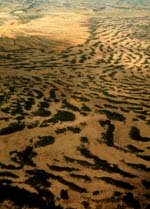In relatively dry areas near deserts, patterns can be formed in the vegetation. Between the shrubs empty spaces appear at regular intervals. These patterns are an indication of the desertification of a region. For his PhD, Sjors van der Stelt studied the mathematical modelling of these areas. Part of this work was carried out at the Centrum Wiskunde & Informatica (CWI) in Amsterdam. Van der Stelt defends his PhD thesis, entitled ‘Rise and Fall of Periodic Patterns in a generalized Klausmeier-Gray-Scott system’, at the University of Amsterdam on Friday 27 January. The ultimate goal of this research is to be able to extract early warning signs of desertification from vegetation patterns. According Wikipedia approximately one billion people live in areas directly threatened by desertification.
Sjors van der Stelt studied mathematical models of semi-arid ecosystems – areas with an annual rainfall between 250 and 500 millimeters, such as parts of the Sahel. When desertification rises, the ecosystem shows patterns that look similar to tiger fur patterns, even so much that they are called tiger bush. Van der Stelt’s research focused on periodic patterns. Until now, ecologists analysed the models with simple methods, which could not predict periodic patterns in vegetation. Van der Stelt was the first to make a specific mathematical analysis, a non-linear analysis of the Klausmeier model, with which pattern formation could be described. He also identified which type of instability causes desertification: the Hopf and sideband instabilities.
Another result of Van der Stelt is the discovery that with decreasing rainfall and diminishing biomass, the distance between the empty gaps (or in mathematical terms: the eigen frequency) in the vegetation often remains constant. That is the reason why gaps in the vegetation are being formed. Van der Stelt says: "In China people try to plant the Gobi desert with grass, soon to find many holes in it. From our model it is clear why this happens: low rainfall makes the condition of homogeneous vegetation unstable. Uniform planting in relative drought is therefore not useful – but it is very expensive, though". The research results are of interest to both ecologists and policy makers.
--
More information:
- homepage Sjors van der Stelt
- UvA news item
The PhD ceremony takes place on 27 January 2012 in the Aula of the University of Amsterdam, Singel 411, 1012 WN Amsterdam.
Supervisor: prof. dr. A. Doelman (Leiden University). Co-supervisor: Dr. G.M. Hek (UvA) en Dr. J.D.M. Rademacher (CWI).

Illustrations: a) Spots in the vegetation (upper image): M. Rietkerk et al. 2002. The American Naturalist 160, 524. copyright 2002, University of Chicago. b) Stripes in the vegetation (lower image): M. Rietkerk et al. 2004. Science 305, 1926.
